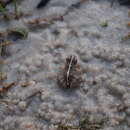Distribution
provided by IABIN
Occurs in Corrientes province, Argentina; east of Santa Cruz department, Bolivia; states of Amazonas, Bahia, Goiás, Mato Grosso, Mato Grosso do Sul, Minas Gerais, Pará, Paranaiba, Pernambuco, São Paulo, and Distrito Federal in Brasil; and Itapúa department, Paraguay.
- author
- Esteban O. Lavilla
- editor
- Diego Arrieta
Diagnostic Description
provided by IABIN
Adult morphology Size small. Heel of extended hind leg reaching to front of orbit. Muzzle a narrow oval as viewed from above, a little longer than the diameter of the orbit, and not projecting beyond the lip-border. Canthus rostralis indistinct. Interorbital space wider than eyelid. Gape of mouth wide. Tongue narrow, extensively free, entire behind. Nostrils two. fifths way from end of muzzle to orbit. Tympanic disc concealed. Second finger ("first ") shorter than third, which is in turn a little shorter than fifth. Two large palmar tubercles. Terminal phalanges not shorter nor expanded at the extremities, but obtuse. The close contact of the third, fourth and and fith metatarsals gives the foot a narrow form, especially as the first and second digits are short. The other digits, especially the fourth, are quite slender, with elongate narrowed terminal phalanges. No dermal margins. Skin generally smooth; no discoidal ventral fold. Color (in preservative) of superior surfaces and sides, black. A broad white band extends from each eye to the groin ; it is distinct in the young, obscure in the adult. It is bounded below by a black band which widens near the axilla, A white line extends on the middle line from the extremity of the muzzle near the end of the urostyle. In the young it sends off a little branch on each side to the eyelid. The upper lip is marked as follows : A white vertical bar marks the middle of the premaxilla; two bars are below the nostril, and two larger ones below the eye. A short distance behind the latter a white stripe commences and extends to the axilla. The superior face of the femur is pale longitudinally; the posterior face is brown, with a pale longitudinal band in the centre. Under surfaces white, except that the throat and breast are faintly brown spotted. The femora are similarly brown spotted in an oblique tract from the anus to the anterior aspect of the knee.
- author
- Esteban O. Lavilla
- editor
- Diego Arrieta
Pseudopaludicola mystacalis: Brief Summary
provided by wikipedia EN
Pseudopaludicola mystacalis is a species of frog in the family Leptodactylidae. It is found in Argentina, Bolivia, Brazil, Paraguay, and possibly Uruguay. Its natural habitats are moist savanna, subtropical or tropical moist shrubland, subtropical or tropical seasonally wet or flooded lowland grassland, freshwater marshes, intermittent freshwater marshes, pastureland, and seasonally flooded agricultural land. It is threatened by habitat loss.
- license
- cc-by-sa-3.0
- copyright
- Wikipedia authors and editors

